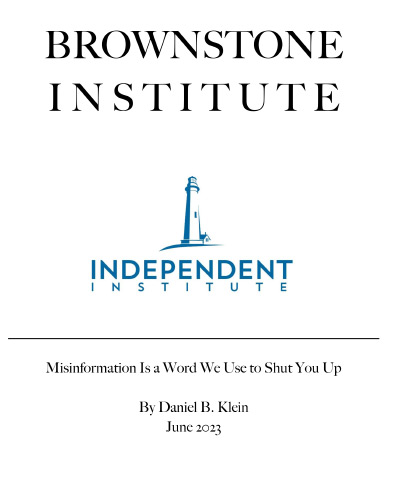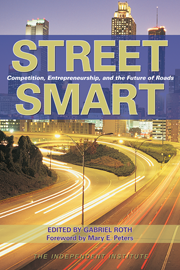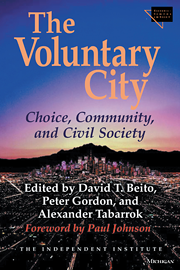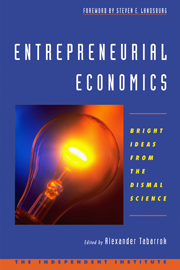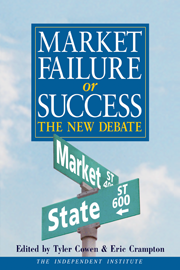Abstract
The policing of “information” is the stuff of Naziism, Stalinism, Maoism, and similar anti-liberal regimes. To repress criticism of their dicta and diktats, anti-liberals label criticism “misinformation” or “disinformation.” Those labels are instruments to crush dissent.
This paper offers an understanding of knowledge as involving three chief facets: information, interpretation, and judgment. Usually, what people argue fervently over is not information, but interpretation and judgment.
What is being labeled and attacked as “misinformation” is not a matter of true or false information, but of true or false knowledge—meaning that disagreement more commonly arises over interpretations and judgments as to which interpretations to take stock in or believe. We make judgments, “good” and “bad,” “wise” and “foolish,” about interpretations, “true” and “false.”
On that understanding, the paper explains that the projects and policies now afoot styled “anti-misinformation” and “anti-disinformation” are dishonest, as it should be obvious to all that those projects and policies would, if advanced honestly, be called something like “anti-falsehood” campaigns.
But to prosecute an “anti-falsehood” campaign would make obvious the true nature of what is afoot—an Orwellian boot to stomp on Wrongthink. To support governmental policing of “information” is to confess one’s anti-liberalism and illiberality. The essay offers a spiral diagram to show the three chief facets of knowledge (information, interpretation, and judgment) plus a fourth facet, fact, which also deserves distinct conceptualization, even though the spiral reminds us: Facts are theory-laden.
Introduction
Writing at Discourse, published by the Mercatus Center, Martin Gurri describes “disinformation” as follows:
The word means, ‘Shut up, peasant.’ It’s a bullet aimed at killing the conversation. It’s loaded with hostility to reason, evidence, debate and all the stuff that makes our democracy great. (Gurri 2023)
That is from Gurri’s excellent piece, “Disinformation Is the Word I Use When I Want You to Shut Up.” The piece prompted the present essay, the title of which is a variation on his.
With such titles, Gurri and I are being polemical, of course. Not all usages of “disinformation” and “misinformation” come from people intent on shutting someone up. But a lot are. The “anti-misinformation” and “anti-disinformation” projects now afoot or in effect are about shutting up opponents.
In 2019 the Poynter Institute for Media Studies published “A Guide to Anti-misinformation Actions around the World.” There you survey examples of anti-misinformation and anti-disinformation projects and policies, which have no doubt soared further since 2019.
The policing of ‘information’ is the stuff of Naziism, Stalinism, Maoism, and similar anti-liberal regimes. In my title “Misinformation Is a Word We Use to Shut You Up,” anti-liberals are the “We.” To repress criticism of their dicta and diktats, they stamp criticism as “misinformation” or “disinformation.” Those stamps are Orwellian tools that anti-liberals wield in the hope of stamping out Wrongthink—for example, on climate, election integrity, the origins of the Covid virus, therapeutics such as Ivermectin and Hydroxychloroquine, the effectiveness of masking, the effectiveness of the Covid injections, the safety of the Covid injections, and the effectiveness of lock-downs. “Anti-misinformation” could be deployed in keeping with whatever the next THE CURRENT THING might be, with associated slogans against, say, China, Putin, Nord Stream, racists, white supremacists, MAGA Republicans, “deniers,” et cetera. And then, of course, there’s all that “misinformation” disseminated by “conspiracy theorists”.
In speaking of “policing,” I mean government throwing its weight and its coercion around against “misinformation” or “disinformation.” And, besides government coercion, there are allies. These allies often enjoy monopolistic positions, stemming either from government handouts, privileges, and sweetheart deals, as with broadcasters, universities, and pharmaceutical companies, or from having cornered certain network externalities, as with certain huge media platforms. Allies of various sorts sometimes do the bidding of the despots because they themselves are threatened and intimidated. The ecosystem leads to their debasement.
To support governmental policing of “information” is to confess one’s anti-liberalism and illiberality. Even worse, it is to flaunt them. The motive is to make and signal commitment to anti-liberalism, in a manner parallel to how religious cults sets up rituals and practices for making and signaling commitments (Iannaccone 1992). Vice signals vice, the ticket in some spheres to promotion and advancement.
Also, vicious action spurs more of the same to defend against exposé and accountability for past wrongs. In protecting their rackets, the wrongdoers verge upon a downward spiral.
Knowledge’s richness
I wrote Knowledge and Coordination: A Liberal Interpretation (Oxford University Press, 2012). The book says knowledge involves three chief facets. Those facets help us see why “misinformation” and “disinformation” are words anti-liberals use to shut people up. The three chief facets are information, interpretation, and judgment:
- Information exists within a working interpretation, natural to the context of the matter under discussion.
- Interpretation takes us beyond the working interpretation. It opens things up to the marvelous generation and multiplying of interpretations; you now face a portfolio or menu of interpretations, and it is a portfolio that can always grow yet another interpretation.
- Judgment is the action facet of knowledge. It is about, first, estimating interpretations and, second, taking stock in certain interpretations you estimate highly. Judgment involves a degree of commitment—belief—which propels you to act on the interpretations you take stock in. If you do not actually act on the interpretation you purport to take stock in, you are a hypocrite and a quack. If you are aware of your hypocrisy, you are a liar; if you are not aware of it, you are in denial, self-deluded. Lying, stubborn denial, self-delusion, and cynicism are features of baseness.
When despots label opposition “misinformation” or “disinformation” they abuse language. They invoke presuppositions built into the word information, presuppositions that are false. When despots label opposition “mis-” or “disinformation, they are, at best, objecting in the interpretation and judgment dimensions of knowledge, or, at worst, they are speaking in a way that has abandoned civil engagement altogether, instead using words as instruments of wickedness.
Usually, what people argue fervently over is not information, but interpretations and judgments as to which interpretations to act on. What is being labeled and attacked as “misinformation” is not a matter of true or false information, but of true or false knowledge. The projects and policies now afoot styled “anti-misinformation” and “anti-disinformation” are dishonest, as it should be obvious to all that those projects and policies would, if advanced honestly, be called “anti-falsehood” or “anti-falseness” or “anti-foolishness” or “anti-untruth” campaigns. But to prosecute an “anti-falsehood” campaign would make obvious the true nature of what is afoot: The persecution and silencing of Wrongthink. In misrepresenting matters of interpretation and judgment as one of “misinformation,” they misrepresent the nature of their projects and dodge the responsibility to account for how they judge among vying interpretations.
Within the information dimension of knowledge, variance is resolved in a straightforward manner. Very little interpretative engagement and dialogue are called for. The question of whether a movie is in black-and-white or in color can almost always be readily decided, because we basically share an interpretation of “black-and-white” and “in color,” making the question a matter of information. If interpretative effort is called for, the matter is no longer within the information dimension—is Citizen Kane a better movie than Roman Holiday? Only to be ironic would someone say: Dad misinforms you when he says that Citizen Kane is better than Roman Holiday. The irony there would be in the implied high self-estimation, as the speaker sets up his own aesthetic sensibilities in judging movies as a standard so precise and accurate as to warrant “misinform” when Dad disagrees with that standard.
The despots are without irony. They dodge interpretive engagement by labeling dissenting statements “mis-” or “disinformation.” They are simply bullying and intimidating their opponents.
We notice that sometimes, as here, announcing BBC Verfiy, the despots use the novel term “mistruth,” which was scarcely ever used prior to a few decades ago (see here). The “mis-” prefix does not well fit on the word truth, which pervades knowledge river-deep, mountain-high. Think of mistake, misspeak, misremember, misplace, mislay, misquote, misdirect, and so on. The prefix “mis-” is proper when the betterness of a readily identifiable alternative—the accurate quotation, for example—is hardly a matter of dispute. I doubt that much time will be spent by BBC Verify on correcting misquotations.
Misinformed by the supermarket clerk
I enter a supermarket and ask a clerk where the peanut butter is, and he responds, “Aisle 6.” I go there but don’t find it. I wander about and find it in Aisle 9.
The clerk was mistaken. He gave me false or bad information. The idea Peanut butter is in Aisle 6 is a matter of information, an idea sitting within a set of working interpretations. The working interpretations include those of ordinary human purpose and of ordinary trust and common decency. The clerk and I were not playing a game, nor was it April Fools’ Day. Importantly, the working interpretations include those of plain English—the semantic conventions of “peanut butter,” “6,” the syntactical conventions of English, and so on.
April Fools’ Day tricks depart from working interpretations. The tricks create an unexpected asymmetry between the interpretation of the targeted person—who wishes to add a dash of salt to his soup—and the trickster—who unscrewed the top of the salt shaker. The target interpreted the world as presenting a salt shaker with top screwed on as usual. The trickster relished her anticipation of the victim’s shock and surprise in discovering the faultiness of his interpretation of the world.
Asymmetric interpretation is essential to humor. Another form of humor is the put-on, as when the trickster feigns his own frustrations, and we enter into the asymmetric interpretations of the amused target of the trick, as in these Buster Keaton put-ons from Candid Camera.
Likewise, humor often plays upon departures from semantic conventions, as in punning, “Knock, knock” jokes, and “Who’s on First” by Abbot and Costello.
A precondition of humor is a certain trust and joint interest in the truths that humor gets at. Without those preconditions, there is no humor.
Despotism conceals its designs. It conceals its true beliefs and intentions. By its nature, it abuses working interpretations. Despotism is untrustworthy. Its relationship with ordinary organic interpretation is never playful. That is why despotism is incapable of being humorous. It cannot make a joke, and it cannot take a joke. Adam Smith wrote:
Reserve and concealment...call forth diffidence. We are afraid to follow the man who is going we do not know where.
Afraid, we attend the despot with diffidence. Despotism is grim.
I take my peanut butter to the check-out line where the same clerk is working, and say, “I found it—but in Aisle 9!,” trying to be humorous as though a joke had been played on me. Being a mere matter of information, the mistake is readily accepted. The clerk responds, “Ah?! Sorry about that!”
Unintentional and intentional
When one person, Bob, misinforms another, Jim, without realizing that the information is false, the mistake is amendable to ready correction, without fuss, assuming the falseness is realized by Jim or Bob. Such misinformation events are trifling; we don’t debate them or dwell on them. Misinformation is rather like a typo, corrected by a proof-reader.
Scarcely ever do we speak of the mistake with the five-syllable Latinate word misinformation. Heavy usage of the word misinformation so often occurs in reference to “anti-misinformation” projects, usage either by the perpetrators and cheerleaders of those projects or by those who fend off threats from the perps.
When Bob misinforms Jim intentionally, however, information mistakes are dishonest. They are lies. We dwell on them as lies, not as matters of misinformation. The misinformer is a liar. Some now promulgate the word disinformation.
In distinguishing misinformation from disinformation, Dictionary.com explains “the critical distinction between these confusable words: intent.” Wikipedia says the same. Its entry on Disinformation begins: “Disinformation is false information deliberately spread to deceive people. It should not be confused with misinformation, which is false information but is not deliberate.”
According to those sources, then, disinformation is lying. It is false information spread by those who know that it is false information. To disinform is to lie.
The distinction based on intent is not sharp. Is the misinformer who does not know that the information he spreads is false but who failed in performing basic due diligence against its falsity a perpetrator of disinformation? His discourse usually carries with it a claim to have done such due diligence, and that claim would be false. And if he knows he has not done due diligence, he is, once again a liar, though the lie is about his having performed due diligence, not about his knowing that the information is false. Out-and-out lying travels with a vast entourage of shabby norms and shabby understandings of the duties of due diligence. Related here would be the large topics of denial, self-deceit, self-delusion, and hypocrisy. (Adam Smith’s treatment of self-deceit is explained here.) The terminus is cynicism, baseness, and miserableness.
In ordinary private-sector affairs, outside of politics and outside of heavily governmentalized affairs, lying at the level of information is naturally checked and counteracted. Again, the “information” implies reference to working interpretations. Getting things right should not be difficult or tricky—issues there are all within the working interpretation. Sure, mistakes are made; but such mistakes are readily and easily corrected.
Liars about information lose the trust of their voluntary associates, whether those voluntary associates are friends, customers, trading partners, or employees. If liars lie about simple features of their products or their services, they could be subject to law suits from their trading partners, to public criticism, and to rival exposé by competitors. In ordinary private-sector affairs, everyone has reputational incentives not to lie systematically, and especially not to lie about information, and most of us have strong moral incentives within ourselves against lying. We dread the disapproval of “the man within the breast”—an expression Adam Smith used for the conscience.
So, you might ask: If private actors without government privileges and immunities scarcely spread false information dishonestly and programmatically, is disinformation really a thing? Before addressing that question directly, let’s turn to the Godzilla of programmatic lying.
Propaganda: Government’s programmatic lies
It is government, especially, that lies programmatically. The lying can be at the level of information, but it usually makes more sense to say that its lying is at the level of interpretation: The government promotes interpretations—for example, The Covid virus came from nature—, interpretations that it, the government, itself does not particularly believe. It lies about the virus having come from nature, as it lies about many other big interpretations. It propagates big lies.
And it lies with confidence. Government is the only player in society that initiates coercion in an institutionalized way. Its coercion is overt. What’s more, it does so on a colossal scale. That is the most essential feature of government. Every government is a Godzilla, and we must learn to live with our Godzilla and mitigate the destruction it wreaks.
The traditional term for government’s programmatic lying is propaganda—a word that once did not necessarily imply falseness (instead meaning simply ideas propagated), but is now generally used in that necessarily-pejorative sense. The falsehoods of propaganda are typically lies, in that the propagandizers usually do not particularly believe the claims they propagate.
Government can lie programmatically because it does not depend on voluntary participation for its support. It subsists on coercion, including restrictions on competitors and opponents, and takings from taxpayers. Organizations in heavily governmentalized settings can also lie programmatically. Crony private-organizations sustain large programmatic lying only when they enjoy privileges, immunities, and protections from the government.
“Misinformation” and “disinformation” are weapons anti-liberals wield
Again, Gurri suggested that, so often, “disinformation” “means, ‘Shut up, peasant.’ It’s a bullet aimed at killing the conversation.” The term “disinformation” scarcely existed before 1980, as shown in Figure 1. The figure contains data through 2019, and it is likely that the recent surge has continued.
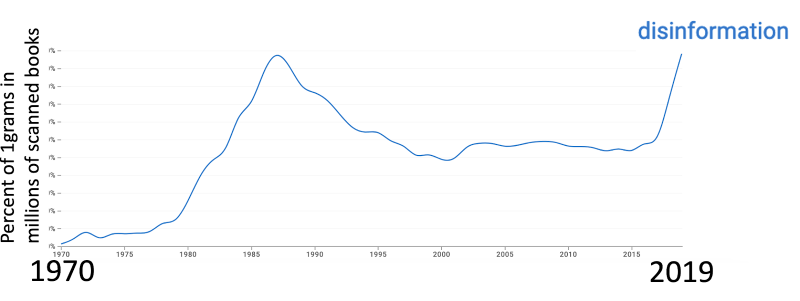
Gilbert Doctorow writes of “the introduction of the word ‘disinformation’ into common parlance.” Doctorow writes:
The word “disinformation” has a specific context in time and intent: it is used by the powers that be and by the mainstream media they control to denigrate, marginalize and suppress sources of military, political, economic and other information that might contradict the official government narrative and so dilute the control exercised by those in power over the general population. (Doctorow 2023)
Gurri and Doctorow are describing what is now the main way, or at least the most troubling and most terrible way, that “disinformation” is used. It must be noted, however, that the word has also been used simply as a synonym of propaganda—and thus something that governments, too, perpetrate. But, now, “misinformation” and “disinformation” are most conspicuously a propagandistic term used in the manner described by Gurri and Doctorow. In that sense, “disinformation” is not a general synonym for propaganda, but is, rather, a word that propagandists use to smear their opponents.
Meanwhile, in fending off this new species of propaganda, honest people, too, resort to using “disinformation,” as a synonym for propaganda, to fling that specific word back onto the propagandists. Doctorow exemplifies what I mean, as he justly writes:
In reality, it is these censorious states and the mass media that carry their messages with stenographic precision into print and electronic dissemination who are the ones that day after day feed disinformation to the public. It is cynically composed and consists of a toxic blend of ‘spin,’ by which is meant misleading interpretation of events, and outright lies. (Doctorow 2023)
Time again we find ourselves having to use the degraded verbalisms of the anti-liberals to address and combat their abuses. Sometimes it seems like our civilization revolves around trying to keep the anti-liberals from burning down the house.
Base humans tend to weaponize things
But aren’t governments accountable to checks and balance, divisions of power, and the rule of law? Haven’t we learned to tame Godzilla, to chain down Leviathan?
It is true that the government of a rule-of-law republic, checked by an honest media, might be quite limited in its programmatic lying. But that’s not how it is today, where dissent is being tarred as “mis-” and “disinformation,” and where the legacy media is morally base in the extreme. Today, regimes are increasingly despotic, and despotic regimes are much less checked and limited.
The rule of law means, first and foremost, the government living up to the rules posted on its own website. Governments today don’t do that. Law is applied politically, that is, with extreme partiality, upon a double-standard. Laws are selectively enforced and punishments are selectively meted out. Despots avail themselves of show trials, kangaroo bodies, and galleries filled with stooges. The “anti-misinformation” agenda is misrule.
Despotism despoils checks and balances. Despotism centralizes power formerly divided. It destroys the independency and autonomy that, theoretically, branches and units, divided and balanced, had once enjoyed. Despotism usurps powers once distributed and balanced. Despotism is unbalanced power.
Under a despotic regime, the coercive institutions unique to government become weaponized by the despots and their allies. They turn them against their opponents. But weaponization is itself always somewhat constrained by cultural norms. The existence of government implies the existence of a governed society, and the existence of society implies the existence of some basic norms, for example against theft, murder, and lying. David Hume famously pointed out that the governed always vastly outnumber the governors, and hence government depends on “opinion”—if only the opinion to acquiesce to those governors:
Force is always on the side of the governed, the governors have nothing to support them but opinion. It is therefore, on opinion only that government is founded; and this maxim extends to the most despotic and most military governments, as well as to the most free and most popular. (Hume, Essays)
I wonder whether the shut-them-up projects of Naziism, Stalinism, and Maoism tarred their opponents with labels akin to “misinformation” and “disinformation.” Even National Socialists and Communists gave some lip service to social norms, with their show trials and righteous objections to “the lying press” (Lügenpresse). But did their languages, at those times, have words that corresponded to the English words information, interpretation, and judgment, along the lines of the distinctions made here? (This ngram diagram makes me wonder.) Was their vocabulary for knowledge like that of English, and did they abuse the presuppositions involved in those distinctions the way that “anti-misinformation” projects do today? For help with this question, maybe we should turn to ChatGPT.
The contested claims go far beyond information
Disagreement usually arises over interpretations and judgments as to which interpretations to take stock in or believe. We make judgments, “good” and “bad,” “wise” and “foolish,” about interpretations, “true” and “false.”
Again, “anti-misinformation” projects presuppose the information dimension where such a presupposition is inapt. When despots declare something to be “misinformation,” the discourser—say, John Campbell, Peter McCullough, Robert Malone—does not readily accept the supposed correction, unlike the clerk in the supermarket example. That is quite decisive proof that presuppositions of the information dimension do not apply. The matter is clearly beyond information.
The despots tend to invoke certain organizations as the definitive, authoritative sources of “information.” They say, in effect: “The CDC, the WHO, the FDA says the mRNA injections are safe and effective, so anything that suggests otherwise is misinformation.” The farce here is pretending that everyone’s working interpretation consists of the dicta of some such particular organization. Never has an organization or agency had such a Mount-Olympus status for determining, throughout society, working interpretations of complex matters, and particularly not an organization with the foul characters and track-records of the CDC, WHO, FDA, and similar highly governmentalized organizations. The similitude to the Soviet Union under Stalin is obvious.
A big part of the interpretation dimension is the estimation of the wisdom and virtue of those who contend for authority. Government is a Godzilla; it is not a validator of an organization’s wisdom and virtue. To be worth a damn, estimations of wisdom and virtue must emerge from arrangements not heavily governmentalized, liberal arrangements, in society, in science, and in public discourse. We shall look not to Godzilla but to certain among the human beings who check Godzilla.
What the sincere human looks like
I wrote above of “quite decisive proof that presuppositions of the information dimension do not apply,” in noting that Peter McCullough does not readily accept the supposed correction. But what if McCullough is a liar? Then it would be no surprise that he does not readily accept the purported correction. What, in other words, about the possibility of disinformation? An insincere disinformationist would stand by his informational statements and persist in misinforming his listeners.
What does sincere engagement look like?
Sincere engagement is sincere in the desire to become better aligned with the larger good, which would correspond to a universally benevolent God. The sincere human does not claim to be universally benevolent. He does not even claim to be more benevolent than the average person. But, compared to the average person, the sincere human scrupulously strives to align his conduct with universal benevolence.
The sincere human wants to be corrected. He welcomes correction. Sincerity is evident in the human’s openness to engagement. The sincere human welcomes deep-dive conversation, debate, and challenge. He is eager to learn.
If the sincere human rejects a purported correction, he is eager to explain the interpretations and judgments that motivate his rejection of the purported correction. He explains why he rejects it. And he welcomes a response to his explanation. He is agreeable to continuing the engagement.
The sincere human wants to sit down, human-to-human, and hash things out. He wants to enter into the mind of his intellectual adversary and see why the adversary says what he says. The sincere human wants to hear about the adversary’s portfolio of possible interpretations. The sincere human is eager to compare the adversary’s portfolio to his own portfolio of interpretations.
In comparing the portfolios, the sincere human may see some interpretations that are not in his own portfolio, and wish to consider those as candidates for incorporation into his own. The sincere human wants to probe their soundness, their worthiness. The sincere human may also see that the adversary’s portfolio lacks certain interpretations that are in his own, and will want to understand why those are lacking from the adversary’s portfolio.
By hashing things out, the two prattlers should aim to get the contents of their respective portfolios onto the table, making a larger union of the contents of the two portfolios of possible interpretations. They can then explore together the reasons, or causes, for their difference in how they judge among the possible interpretations. They try to dwell in one another’s mind, sympathetically, to get a feeling for the ways of the other’s judgment. After doing so, each can then make a moment in the other’s judgment into an object up for examination, an object for interpretation and estimation. “But why do you draw that conclusion?”
The sincere human is frank and open about the calls of his own judgment. He invites the other human to ask, “But why do you draw that conclusion?” Adam Smith wrote: “Frankness and openness conciliate confidence.”
When two sincere humans disagree, it is as if they say to one another:
We both purport to orient ourselves upward, toward alignment with the good of the whole. We both understand that our thinking must focus on the most important things in the issue at hand. We both look at the same world—our interpretations are, as it were, interpretations of the signals presented to us in the book of nature. And yet we draw different conclusions. Let us explore the sources of that difference, in the hope that as a result there will be an improvement, for the good of the whole, in the joint effect of (your revised outlook and my revised outlook), after your outlook and my outlook have been revised by virtue of our conversation.
That is what the sincere human looks like. He is open, frank, and eager to participate in conversation and debate with adversaries. He is eager to sit down and hash things out. He is eager to delve into the fine points, to nail down the details, to respond to challenges, to document the evidence, to continue the conversation. He relishes engagement as a sort of adventure of the mind. He takes joy in argumentation and scholarship, as actualization of the human potentiality for virtue—of serving God, as it were.
The sincere human looks like—from what I can tell—Peter McCullough.
I single out Peter McCullough as exemplar simply to single out someone. All of those who are eager to engage adversaries illustrate the most salient feature of the sincere human, and the more that that eagerness fits the rest of my description above, the more sincere that human likely is.
The sincere human loves life, and hence loves the most rewarding, most sublime of life’s experiences. For scholars, researchers, thinkers, and indeed for Man Thinking everywhere, as humans in continual discourse about our duties to the good and our dependence on interpreting the book of nature, one of the most rewarding, sublime experiences is the sort of civil engagement described above. The sincere human, then, holds the norms, practices, and institutions that foster and safeguard that sort of civil engagement to be sacred. The sincere human, therefore, is not only a liberal in the pre-political senses of the word, but also in the political sense christened “liberal” around the 1770s by Adam Smith and other Britons. That is the political outlook that best sacralizes the norms, practices, and institutions of sincere engagement.
What the unsincere human looks like
We now turn to characters opposite of the sincere human. One would be insincere, but I wonder whether another is the human without either sincerity or insincerity. I will use “unsincere.”
The features of the unsincere human are generally the opposite of the just-described ways of the sincere human. The unsincere human is not open. He is averse to sitting and hashing out differences with adversaries. He may issue brief, peremptory messages. He avoids challenges. He ignores criticism. He does not explain. He refuses engagement.
The most vicious humans hate to see adversaries finding platforms and channels to challenge their projects; they work to shut them up. Other humans fall in with, or at least stays silent about, the assaults on liberal norms and institutions, such as “anti-misinformation” projects.
The unsincere human is illiberal, and he tends to subserve anti-liberalism, even if he does not himself mouth the slogans of anti-liberalism.
Fact
I return to elaborating an understanding of knowledge, because I think that getting the understanding across can be useful to sincere efforts to advance the good. (At the end of this paper is a listing of a few philosophers whose thinking my thinking dovetails with.)
Again, the chief facets of knowledge are information, interpretation, and judgment. What about fact? Is fact not a facet of knowledge?
Consider the saying, Facts are theory-laden, a saying that got started in the 1960s. To relate that saying to my terminology, think of “theory” as interpretation judged worthy or superior. Theory, then, refers to the dimensions of interpretation and of judgment.
Facts are theory-laden is a useful saying, for it reminds us that what one person calls “fact” can be opened up to examination and challenge by another person—or even by the same person, a moment later, after having called it “fact.” The simple truth is that we could, if we had cause to, dig interpretation and judgment out from underneath any of our facts.
Facts are theory-laden, but when “we” all embrace the laden theory, we call the statements fact. To call something fact is to declare that the laden theory is not the matter under discussion. Fact, then, is a facet of knowledge, but not a chief one. Fact designates statements that no one among “us” wishes at all to take issue with. Facts are noncontroversial, at least for the discussion within which they are treated as facts.
A diagram may be helpful.
The spiral of knowledge
Communication picks up midstream of human experience. We proceed upon working interpretations. “Information” is what we call the facts as seen within the working interpretation.
fact, information, interpretation, and judgment
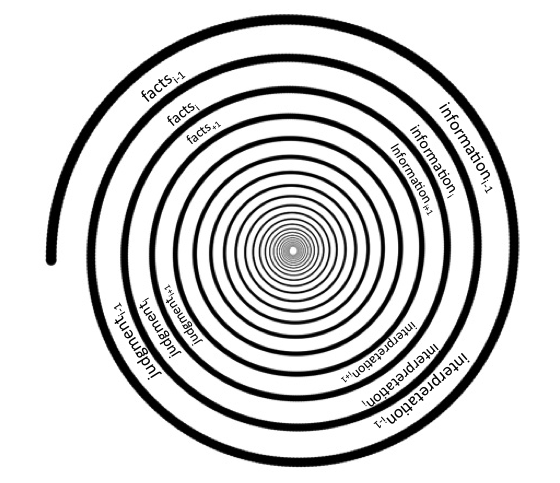
Figure 2 offers four phases (or facets) of knowledge, shown in each loop of the spiral. “Facts” reside in a more basic interpretive frame—more basic than what I have called “the working interpretation”—in which “factual” statements are presumed acceptable to all parties of the communication. When Jane and Amy “argue over the facts,” they are, as it were, revisiting what is to be treated as factual.
The loops flow one into the next, through time, from outer loops to inner loops. We travel in the clockwise direction. The spiral image on your screen is two-dimensional, but imagine a third. We hope that the spiral winds upward in wisdom and virtue, such that the inner loops are higher than the outer loops.
Suppose we sit down together with a telephone book. We call the ink markings “the facts.” Neither of us thinks to dispute statements about the printed numbers on the pages. We then proceed to talk plainly of them as phone numbers. We often forget this working lens—interpreting the facts as phone numbers—because we see through it.
One of us, however, may propose another interpretation: Might the list of “phone numbers” contain secret knowledge encoded by spies?
Thus, we have multiple interpretations of the ink markings that some understand as “phone numbers.” Those quotation marks signal: what the facts are called when they are seen through the working interpretation. But we may more directly speak of multiple interpretations of the information, as opposed to multiple interpretations of the facts. Thus, rather than interpretively pivoting off the “fact”-level interpretation—that the line reads 678-3554—let’s pivot interpretively off of what I have called “the working interpretation”—that 678-3554 is a phone number—a level up from the factual, and there the pivot then turns to open up the interpretation dimension: “Maybe the phone number is a secret encoded message?” Again, universal acceptance among the “we” is built into “the facts”: None of us disputes that the line says 678-3554. Wherever you want to accommodate interpretive pivoting, move “factual” to somewhere down from there.
Meanwhile, life rolls on, and we are called to act. The pitch races toward the plate. If the batter waits for a better interpretation, he may be called out on strikes. Again, the action facet of knowledge is judgment. As speaker, we judge of judgments—of our interlocutors and of agents existing within the descriptions we give of things. We convey our judgments of their judgments using judgmental terms.
If, among our circle of “we,” judgment is shared, then those judgments may now predicate a further conversation among us, and, thusly, those judgments present statements now treated as fact. Thus, we have completed the phases of the spiral and have moved from one loop to the next, where the sequence of phases may recur.
Despotic contempt for our circle of “we”
Again, what is labeled and attacked as “misinformation” or “disinformation” is not a matter of true or false information, but of true or false knowledge. Recognizing that knowledge, not merely information, is at issue is a matter of common decency.
The dignity of sincere discourse involves an openness, in principle a universal openness, to other human “we’s” and their pursuits upward in wisdom and virtue. As we can see, the chief facets of knowledge—information, interpretation, and judgment—operate both behind and ahead of our current position in the spiral. Trying to shut us up is to show a despotic contempt for our way of weaving through the phases of knowledge. It is contemptuous towards the development of the many loops within which our sense-making has made a home and now operates.
By weighing interpretations and making judgments, we establish certain beliefs as fact, to predicate our further conversation. Those beliefs reflect a “we” with those beliefs. Meanwhile, in the wider world, different “we’s” are forming and are addressing the public at large, representing different sets of belief, different ways of making sense of the world. We might call a “we” a distinct sense-making community.
The sincere human of any one of these communities is eager to learn from other communities. The sincere human has certain commitments which make it belong to the sense-making community it belongs to, but it is not wedded to that community. In fact, the entire population of that community—that is, the set of people who currently share that way of sense-making—may remake their community’s way of sense-making. Those who learn from other communities may become leaders of intellectual change within their own community.
Thus, sincere humans favor the freedom of speech and the norms of frank and open discourse for all communities. Besides favoring that freedom, they welcome engagement across communities, for all the reasons given earlier.
The “anti-misinformation” despots show contempt for communities at odds with their dicta and diktats. Not only are the members of the “anti-misinformation” community unwilling to engage in civil debate, but they promulgate “anti-misinformation” propaganda so as to intimidate their adversaries, to crush dissent.
I have explained that the “misinformation” characterization of the disagreement is false. The anti-liberals are presupposing that it is a matter within the information dimension of knowledge, when clearly the disagreement involves contentions in the interpretation and judgment dimensions. Under pretense of combatting misinformation, they are really just stomping on adversaries. As I said at the outset, it is akin to Naziism, Stalinism, and Maoism, regimes that likewise showed despotic contempt for sense-making communities at odds with their own. “Anti-misinformation” projects are a sham, just as “anti-racism” projects are a sham.
A few words about “hate”
"We're a hate group... We hate hate." — Get Smart
Just as “anti-misinformation” projects are despotic, so too are “anti-hate-speech” projects. The failure is again one of bad semantics and false presuppositions. “Anti-misinformation” despots tar their opponents with “misinformation,” making an “information” category error based on a false presupposition. “Anti-hate speech” projects tar their opponents with “hate,” again making a category error, for they treat hatred as necessarily hateful—that is, improper. Figure 3 shows the recent onset of “hate speech” and “hate crime.”
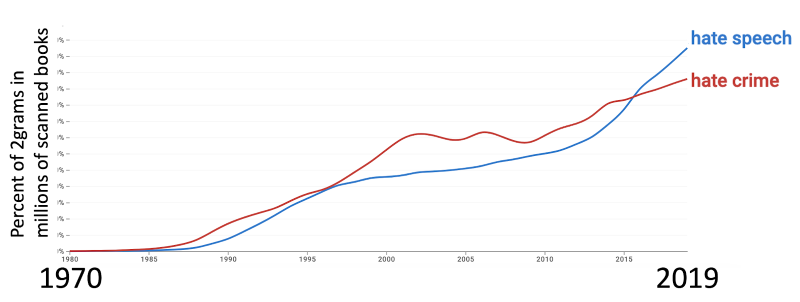
But hatred is a necessary and organic part of any coherent system of morals. A coherent system of morals holds love and hate to be counterparts to one another. In a coherent system of morals, love is to be felt toward objects that are loveworthy, and hatred is to be felt toward objects that are hateworthy, although the bounds of propriety for the intensity and expression of the two respective feelings are importantly different, as Adam Smith explained (see esp. TMS, Part I, Sect. II, Chaps. 3 & 4 on the “unsocial” and “social” passions).
Moreover, the two respective sets of objects bear a counterpart relation to one another, for that which works systematically against the loveworthy is hateworthy. As Edmund Burke wrote: “They will never love where they ought to love, who do not hate where they ought to hate.”
The implicit denial by anti-liberals that hatred is a necessary and organic part of any coherent system of morals is parallel to their implicit denial, in treating interpretive matters as informational matters, that asymmetric interpretation is a necessary and organic part of any coherent society of modern human beings. Just as “mis-” and “disinformation” are words they use to shut you up, “hate speech,” “hate group,” and “hate crime” are words they use to shut you up, ratified by show trials and kangaroo bodies. A proper court of hate would presuppose a distinction between proper hate and improper hate, just hate and unjust hate. In a liberal civilization such “courts” are not governmental. Rather, they remain in the judgment and interpretation of the individual’s own being. If hate is policed in the manner that outward action is policed by governments,
we should feel all the furies of that passion against any person in whose breast we suspected or believed such designs or affections were harboured, though they had never broken out into any actions. Sentiments, thoughts, intentions, would become the objects of punishment; and if the indignation of mankind run as high against them as against actions; if the baseness of the thought which had given birth to no action, seemed in the eyes of the world as much to call aloud for vengeance as the baseness of the action, every court of judicature would become a real inquisition. (Smith, TMS, italics added)
Concluding remarks
The “anti-misinformation” projects are obvious miscarriages of civility, decency, and the rule of law. We must rediscover the norms of openness, tolerance, and free speech that dignify humankind. Science depends on confidence, and confidence depends on those liberal norms. Those norms are the parents of good science, healthy sense-making, and civil tranquility. There are two roads here, namely:
- Freedom —> openness —> confidence —> truth-tracking —> dignity;
- Despotism —> concealment —> diffidence —> bad science —> serfdom and servility.
Let’s get back to the right road.
Appendix: Philosophical affinities
FWIW: My take on knowledge has affinities to the philosophizing of David Hume, Adam Smith, Friedrich Hayek, Michael Polanyi, Thomas Kuhn, Iain McGilchrist, and many others. It also has affinities to the pragmatists William James and Richard Rorty, but I regard pragmatism—seeing one’s belief as the product of one’s choosing an idea among alternative ideas, and seeing the chosen idea’s betterness (compared to actual alternatives, not compared to the past or to hypotheticals) as necessarily the chief basis for what one shall count as true—as a phase situated on one side of a spiral, counterposed by, on the other side of the spiral, an alternate phase that we may call Humean natural belief. Humean natural belief is belief that has emerged from depths beyond the loop in which we pass between the two phases; Humean natural belief is, within that loop, not to be treated in terms of choice; it is what we would call, as we dwell within that loop, brute reality. To open such brute reality up to the pragmatist phase would mean acceding to another loop of the spiral. But the spiral is indefinite, with no first (or lower-most) loop and no final (or upper-most) loop, so certain brute realities at some loop or level remain brutish for any finite conversation. And all conversations are finite.
Selective References:
Burke, Edmund. 2022. Edmund Burke and the Perennial Battle, 1789–1797. Eds. D.B. Klein and D. Pino. CL Press. Link
Doctorow, Gilbert. 2023. The Western Media Disinformation Campaign: Fall of Bakhmut, a Case in Point. Gilbert Doctorow website. Link
Gurri, Martin. 2023. Disinformation Is the Word I Use When I Want You to Shut Up. Discourse, March 30. Link
Hume, David. 1994. Essays, Moral, Political, and Literary. Edited by Eugene F. Miller. Indianapolis: Liberty Fund. Link
Iannaccone, Laurence. 1992. Sacrifice and Stigma: Reducing Free-riding in Cults, Communes, and Other Collectives. Journal of Political Economy 100(2): 271–291.
Klein, Daniel B. 2012. Knowledge and Coordination: A Liberal Interpretation. Oxford University Press. Link
Polanyi, Michael. 1963. The Study of Man. Chicago University Press.
Smith, Adam. 1982 [1790]. The Theory of Moral Sentiments. Edited by D.D. Raphael and A.L. Macfie. Oxford University Press/Liberty Fund. Link

.png)
